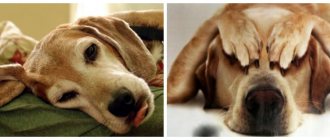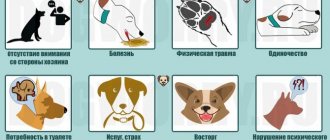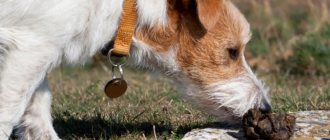Animal lovers know that dogs can often whine. It's time to figure out the reasons and understand what needs to be done.
Dogs cannot communicate sadness to their owner using words. However, animals often try to attract the owner’s attention by whining. Sometimes dogs can whine just like that, for no particular reason, however, as a rule, there really is some kind of problem, for example, the dog is sick, hungry, stressed, and so on. Let's figure out together why a dog can whine, thereby disturbing the silence.
Why does an adult dog whine?
Whining is common in adult dogs. This behavior may be associated with health problems, characteristics of upbringing and behavior, and living conditions. If your pet constantly whines even without obvious reasons, you should contact a dog trainer or veterinarian. Below are the main reasons why a dog cries and cannot find a place for himself.
Health problems
If you notice that the animal is trembling and whining pitifully, this may be due to physiological problems. Possible causes and typical manifestations:
- Diseases of the musculoskeletal system. This may be the destruction of joints due to age or pain after an injury. The dog may whine, limp and move poorly. Most often, the dog takes a comfortable position and finds it difficult to get up and walk. In this case, it is recommended to carry the pet only in a horizontal position.
- Pathologies in the oral cavity. Sharp objects and pieces of food often get stuck in the mouth. If you notice that the animal is breathing frequently or making unusual sounds, you should check the condition of the gums and teeth.
- Ear diseases. Ear mites and common otitis media are more common, causing the dog to scratch its ears and whine. A veterinarian examination is required.
- Indigestion. Characteristic features are refusal to feed, changes in behavior after eating, vomiting and diarrhea. It is recommended to undergo a full diagnostic to accurately determine the cause of this problem.
- Infestation with parasites. If you notice that your dog whines when he poops or rides on his butt after defecation, he may be infected with worms. For treatment and prevention, special anthelmintic drugs are prescribed.
A dog that whines can signal its health to its owner. If this is accompanied by a violation of the usual lifestyle, refusal of water and food, you need to show your pet to a qualified veterinarian.
Behavior problems
The most common reason why a dog whines is its reaction to living conditions, as well as mental characteristics. Whining is most common in restless and anxious pets when the owner leaves. The main factors triggering atypical behavior:
- the bitch's reaction to being weaned from her puppies, which can last up to several weeks. In this case, the dog hardly sleeps at night, walks around the house and makes various sounds;
- loud noises outside the house - thunderstorms, firecrackers, car alarms and gunshots. The dog runs around the apartment, behaves restlessly and hides in the darkness;
- boredom for the owner when the dog is left alone. A similar reaction can occur when kept in an apartment or in an enclosure;
- whining in dogs is also observed after punishment by their owner for any offense or fault. Usually the dog stops whining after reconciliation if the owner offers a treat.
In addition, the dog may whine after any surgical intervention, for example, after sterilization. In this way, the animal demonstrates discomfort and pain. Often, bitches whine after estrus, which is caused by changes in hormonal levels; normally, this behavior goes away within 1-2 days.
Behavior driven by instincts
Dogs are hunters by nature, and this quality manifests itself to varying degrees in different breeds. If you notice that the dog is thrashing around and whining, then perhaps he has noticed the prey, but cannot catch it. This problem is often observed in dogs that spend a lot of time on the balcony or in an enclosure. Overexcitation from the sight of birds, cats and other animals running nearby can persist even after castration in male dogs.
Psycho-emotional factors
A common reason why a dog whines. In this way, animals express their emotions, reactions to the owner and external factors. It could be joy, excitement, fear or worry. Whining can be triggered by various reasons:
- the appearance of a child or a new animal in the house;
- boredom of the owner when they are left alone all day;
- reaction to returning after a walk;
- dreams (when a dog whines in his sleep).
If the dog is shaking with excitement and cannot calm down for a long time, you need to offer it a treat, pat it a little at the withers or stroke it behind the ears. Some dogs begin to be cunning - they whine to beg for food or a walk. For example, a dog sits on its hind legs and looks straight into the eyes, making various sounds. This behavior should be stopped by expressing dissatisfaction and reprimanding your pet.
What do animals dream about?
So far no one has been able to “spy” on the dreams of animals. However, scientists have reason to believe that they are more diverse than we might imagine. Definitely, often a dream is a reflection of what has been experienced. Therefore, the central part of the plot is usually the owner, who is the center of the universe for the dog. Often dogs in which the “blue spot” was neutralized, in the active phase of sleep, did everything the same as during the day: played, followed commands, ran.
However, studies have shown that it is during sleep that ancient instincts manifest themselves in animals. Thus, even trained dogs, whose ancestors served humans for many generations, can begin to howl like wolves during the deep phase. And under the influence of drugs, they completely demonstrated original behavior: even decorative dogs could “go hunting” and demonstrate behavior characteristic of their ancestors in the pack.
During sleep, ancient instincts appear in an animal
Why does a puppy whine?
Puppies weaned from their mother take a long time to adapt to the conditions in their new home. The period of addiction is enhanced by active physiological changes in the body. This is why a puppy may make whining sounds during the day, but almost always stops whining at night. Main reasons:
- weaning from the bitch and her litter, getting used to new smells;
- discomfort after vaccination;
- fear when the dog is left alone;
- various diseases, helminthiasis;
- lack of attention of the owner;
- anxiety when changing your lifestyle, being transported in a car, or after meeting new people.
If you notice that your pet is shaking and crying, you should calm the puppy down as quickly as possible. To do this, take it under your front paws, hold it close to you and stroke it in the direction of hair growth, behind the ears. If the animal is under 2 months old, offer a pacifier with milk or a special formula. Puppies should absolutely not be scolded, as this can cause serious changes in the psyche, severe human fear and chronic somatic diseases.
Folk signs
The puppy whines when left alone: how to wean it off
Dogs are sensitive creatures. They can not only sense the mood of the owner, but also predict the future. Many centuries ago, people believed that the howling of a dog meant misfortune in the house: illness or death. If a whining dog was looking at a house, it meant that there would be a fire or theft there in the future. Howling at the moon signaled great trouble.
For your information! The ancestors were most afraid when a dog whined while holding its head straight, because this foreshadowed war or famine.
When a dog whines for no reason
Dog handlers agree that a dog cannot whine without a reason. This is always an expression of well-being, one’s own emotions or a way of communication. If you notice that your pet has begun to whine without any provoking factors, you should check his health (examine the oral cavity, change the temperature, take him to an appointment).
It is especially dangerous if the dog, at the same time as whining, is breathing heavily, shaking his head with his tongue hanging out, or pacing around in the apartment. If these symptoms occur, you should take your pet to the vet as soon as possible.
Pain and feeling unwell
Whining as a sign of malaise is the most dangerous of the reasons. Dogs rarely whine during chronic diseases and aching pain (dental pain, in joints, in the abdomen), but often after operations, during injuries, acute pain syndrome and diseases accompanied by itching. Here you need to observe your pet in order to be able to describe the symptoms to the doctor. This will help in making a diagnosis. For example:
- With ear infections, the dog shakes its head and whines;
- Squeaks during defecation or urination indicate sharp pain, indicate cystitis, constipation, hemorrhoids, etc.;
- Whining after eating indicates gastrointestinal diseases;
- The dog may bite fleas near the tail, whining from itching and indignation.
- Aging animals may whine or even howl due to cognitive decline: confusion, anxiety, dementia.
How to stop your pet from whining
First of all, you should understand the reasons why the dog is whining, and only then take active action. In most cases, it is enough for the animal to satisfy its physiological needs - for this it needs to be fed, walked, if it asks to go outside. Sociable dogs require attention, especially if you have not been around for a long time. Steps to quickly calm your pet:
- consciously ignore if your pet tries to get your attention by whining;
- offer a favorite toy, bone or treat;
- distract by executing practiced commands;
- caress and scratch, pick up.
From a young age, you should not allow your pet to violently express its emotions. If he starts barking or whining when overexcited, he needs to be calmed down immediately and his energy transferred to active behavior and communication.
If firecrackers and fireworks are planned, it is recommended that the dog be kept in a confined and dark area where he can be safe (for example, in the bathroom or bedroom). Drinking water and food must be left there.
Puppies should be taught to be alone almost as soon as they arrive in the house. Gradually increase your weaning time from 2 minutes to several hours. Immediately after returning, praise for waiting and give a treat. It is useful to install a camera in the apartment so that you can monitor the dog while you are away. This is especially beneficial for active breeds such as huskies, large terriers, boxers and pit bulls.
Communication method
Little puppies whine for their mother. On other adult dogs, their squeak has a calming effect, showing that in front of them is a defenseless creature that cannot be touched. After weaning, the puppy will continue to call his mother for some time, whining and being bored. Later he can apply a similar method of communication to the owner, call, attract attention, ask, etc.
An adult dog, with the help of whining, shows respect for the dominant (another dog or person). At the same time, she often takes a submissive pose: lying on her side or on her back.
If in the private sector dogs usually bark, then in apartment buildings you can hear “choral singing.” Someone on the fifth floor was sad, on the second floor he was hungry, and on the seventh floor, a dog quite happy with life whined “for company,” and perhaps this was an expression of support and sympathy.
Briefly about the main thing
- A dog can whine due to health problems, against the background of psycho-emotional factors, and as a way of communication.
- Bitches after estrus and during false pregnancy can whine with a toy; whining is also observed when overexcited.
- Dogs dream, so they may whine and move their paws while they sleep. This reaction is more common in puppies.
- In order for your pet to stop whining, you need to understand the reasons for this behavior. If necessary, contact a veterinarian.
Does your dog whine towards the apartment? Write in the comments how you deal with this behavior.
How do dogs' dreams differ from human dreams?
With the advent of technology that allows one to monitor brain activity during sleep, experiments on dogs were continued. With their help, it was possible to prove that dog dreams are different from human dreams. They are brighter, more dynamic, and quickly replace each other. Thus, the deep sleep phase in a person can last about one and a half hours. During this time, he manages to view the whole story. In dogs, it takes on average 20-25 minutes, and the dream consists of 2-3 pictures that quickly replace each other.
Interesting! In small breeds of dogs, sleep phases alternate more often than in adults. So, in a toy terrier this can happen every 10 minutes, in a Great Dane - every hour.
Scientists are also inclined to believe that during sleep, animals can not only see and hear, but also smell. This is evidenced by the fact that they often twitch their nose in their sleep, as if sniffing at something.
In small breeds of dogs, sleep phases alternate more often than in adults
Injuries
Immediate assistance should be provided to the dog if it suffers a major injury.
Most often, dogs receive auto injuries, as a result of which they fall into traumatic shock - the body’s general reaction to severe injuries with severe disruption of tissue blood flow. The regulation of vital organs and systems of the body is disrupted. Such shock can be caused by injury, fractures, hemorrhage, or crushed limbs.
Time: immediately
Symptoms: During the erectile phase of shock, the dog shows general anxiety, the temperature may rise or remain normal. The torpid phase is characterized by depressed consciousness, the pupils react poorly to light, and the mucous surfaces turn pale.
For urgent transportation to the clinic, you can use a blanket; if there is a suspicion of a spinal fracture, you need to use a rigid shield for transportation.
Convulsions
If tonic-clonic seizures (epilepsy) occur, veterinary assistance is required no later than 30 minutes.
Time: no more than 30 minutes
Symptoms: chaotic movement of all limbs begins, the dog continuously moves its jaws. The pupils dilate, profuse salivation, spontaneous bowel movements and urination occur. Consciousness is not lost, but disorientation may occur.
Before emergency veterinary help arrives, the dog should be in as calm an environment as possible; it reacts sharply to light and sharp loud sounds, which can prolong the attack, which will worsen the dog’s condition. You need to call the dog by name, this can sometimes help bring him out of this state. The dog needs to be fanned with newspaper, and its limbs and lower abdomen should be moistened with water at room temperature. While waiting for the doctor, you can inject Valium, Seduxen or Relanium intramuscularly or intravenously.
This is interesting: How to cook salmon deliciously
In what cases is a visit to the clinic strictly necessary?
In what cases is a visit to the clinic strictly necessary:
- The dog is in obvious pain.
- The pet developed wounds, scratches, and eczema.
- There are strong changes in appetite.
- The dog refuses water.
- There is a sharp gain or loss of weight.
- The dog is suffering from fever.
- There are signs of allergy or intoxication.
- The dog's mucous membranes turn blue when excited or when it calms down.
It is important to understand that constant anxiety will remain a psychological problem “for the time being.” Stress can cause or exacerbate diseases of absolutely any type. It has been proven that dogs that constantly live in a stressful environment are more prone to contracting viral, infectious and even colds.
Useful tips
If for some dogs whining is a necessary measure, they rarely resort to this method of communication, then others are very emotional by nature. Such breeds need to be raised from childhood, otherwise feelings will overwhelm them in any ordinary situation.
Some useful tips on how to stop your dog from whining all day:
- Teach from an early age that there is no need to express emotions violently (barking, whining). If such overexcitation occurs, switch the dog to games or training (active action).
- If changes are planned, such as moving or having a child, be as attentive as possible to your pet. Show care, spend time with him, be sure to take your favorite toys and bedding to a new place.
- Plan your pet's daily routine so that it satisfies its physical activity. Remember that a Pug and a Jack Russell Terrier have different exercise needs. Active breeds need to run, jump and move a lot, otherwise they will waste their energy destroying the apartment.
- Make your pet's corner cozy and suitable for him: a comfortable bed, a large number of toys. Assess your friend's temperament: some dogs love privacy, a soft, semi-closed house is suitable for them, while others want to have a lot of fun, for them choose toys that squeak, rustle, and run away.
- Be prepared for what the animal is afraid of. For example, fireworks or thunderstorms. In the first case, on major holidays, when a lot of fireworks go off, it is better to lock the dog in a dark, quiet room, for example, in a bathtub, after putting a bowl of water there and putting a bed down. In the second case, when it is difficult to predict natural phenomena, try to be nearby, hold and stroke the dog.
You will make your life much easier if you accustom your pet to a routine from an early age. Then he will know that at a certain time you walk, then eat. That you are not at home during the day, but you come back and spend time with him, play in the evening. With this kind of training, the dog will know when and what to expect.
In conclusion, it must be said that the most important thing when frequent whining appears is to make sure that the dog is healthy. Pay attention to little things, behavior, if alarming symptoms appear, do not wait until they worsen, consult a doctor immediately. Otherwise, remember that animals, regardless of age, are children, they need your support and care.
Acute poisoning
In case of acute poisoning by toxic substances, it is necessary to prevent re-ingestion of them into the body and immediately call the clinic.
Time: immediately
Symptoms: the dog begins to fall, grind its teeth, and twitch its head. Vomiting, excessive salivation and convulsions begin. Consciousness becomes clouded, and the dog may behave aggressively and uncontrollably. Sometimes, on the contrary, it can show oppression, apathy and hide from people.
If a dog has swallowed poison, it can be given adsorbents: talc, activated carbon, milk. If poison gets on your skin, wash the affected area with cool water (and soap).
The dog’s further health, and sometimes its life, will depend on the owner’s timely visit to the clinic.
Arterial bleeding
In case of severe arterial bleeding, the necessary assistance should be provided no later than 30 minutes. External bleeding occurs when soft tissue is injured. With arterial bleeding, rapid blood loss occurs, which can result in the development of traumatic (hemorrhagic) shock, accompanied by a sharp drop in pressure.
Time: no more than 30 minutes
Symptoms: An outpouring of a stream of scarlet blood (the darker color is venous blood), the outflow of blood occurs from the entire surface of the wound. Hemorrhagic shock is accompanied by adynamia and a weak pulse, which can lead to the death of the dog.
Before arriving at the clinic, you can apply a tourniquet above the damaged area, and place a piece of fabric under the tourniquet. If there is no tourniquet, you can clamp the artery with your hand.











